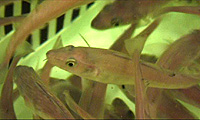| Top speed for cod 2007-11-27 |
| The National Cod Breeding Centre in Norway has produced more cod than ever this year - and with 190 families it's virtually a full house at the facility. It's now five years since the National Cod Breeding Centre was established in Tromsø. Production has increased every half-year and a new record has been achieved again this year. "Our aim was to produce 200 families. We managed 190 and we are extremely satisfied", says Atle Mortensen, who heads the National Breeding Programme for Cod operated by Fiskeriforskning. "We have now reached the production level we want."  Effective production Production and fish quality has continued to improve on an annual basis. This is due in part to the staff becoming more experienced and skilled in this field. "One of the methods we use is to remove fertilised roe of poor quality. In this way, we don't waste time and capacity feeding fish we can't utilise and this enables us to concentrate on producing fish of high quality", says Mortensen. Electronic tags A total of 30,000 cod will this year be tagged, weighed and measured. An electronic tag is placed in the fish's abdomen to enable identification of each fish. Around 20,000 fish will be used in the ongoing breeding programme, while the remainder will be used for research in areas including susceptibility to disease. Fry for fish farmers Last year fish farmers were supplied fertilised roe from the first generation breeding cod. "The large production this year has provided more fry than we require," explains Scientist Øyvind Hansen. A surplus of 240,000 fry was this year sold to fish farmers in Helgeland. Geographic distribution The cod tagged in autumn will be released in spring. The fish will be divided between the Aquaculture Research Station at Ringvassøy near Tromsø and pilot plants at Bergen and Kirkenes. Geographic distribution makes it possible to study whether some families are better equipped to grow in the south or north. Solid foundation Three years must elapse before one generation can parent a new generation. The breeding programme concentrates on achieving farmed cod which grow more rapidly than their fellow species in the wild. The second objective is greater resistance to disease. "With the large number of families, we have a solid foundation for ongoing breeding", says Mortensen. Source: Fiskeriforskning See video (in norwegian language only) For more information, please contact Atle Mortensen, phone +47 77 62 92 38. |
| tilbage |
Copyright © AquaCircle. Ophavsret
